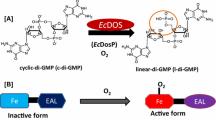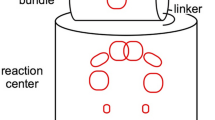Abstract
The oligomeric state of human porphobilinogen synthase (PBGS) [EC.4.2.1.24] is homooctamer, which consists of conformationally heterogenous subunits in the tertiary structure under air-saturated conditions. When PBGS is activated by reducing agent with zinc ion, a reservoir zinc ion coordinated by Cys223 is transferred in the active center to be coordinated by Cys122, Cys124, and Cys132 (Sawada et al. in J Biol Inorg Chem 10:199–207, 2005). The latter zinc ion serves as an electrophilic catalysis. In this study, we investigated a conformational change associated with the PBGS activation by reducing agent and zinc ion using analytical ultracentrifugation, negative staining electron microscopy, native PAGE, and enzyme activity staining. The results are in good agreement with our notion that the main component of PBGS is octamer with a few percent of hexamer and that the octamer changes spatial subunit arrangement upon reduction and further addition of zinc ion, accompanying decrease in f/f 0. It is concluded that redox-regulated PBGS activation via cleavage of disulfide bonds among Cys122, Cys124, and Cys132 and coordination with zinc ion is closely linked to change in the oligomeric state.



Similar content being viewed by others
References
Arakawa T, Philo JS, Ejima D, Tsumoto K, Arisaka F (2006) Morpheeins—a new structural paradigm for allosteric regulation, trends. BioProcess Int 4:32–42
Bevan DR, Bodlaender P, Shemin D (1980) Mechanism of porphobilinogen synthase. Requirement of Zn2+ for enzyme activity. J Biol Chem 255:2030–2035
Brandt U, Kerscher S, Dröse S, Zwicker K, Zickermann V (2003) Proton pumping by NADH:ubiquinone oxidoreductase. A redox driven conformational change mechanism? FEBS Lett 545:9–17
Breinig S, Kervinen J, Stith L, Wasson AS, Airman R, Wlodawer A, Zdanov A, Jaffe EK (2003) Control of tetrapyrrole biosynthesis by alternate quaternary forms of porphobilinogen synthase. Nature Struct Biol 10:757–763
Cedervall T, Berggård T, Borek V, Thulin E, Linse S, Åkerfeldt KS (2005) Redox sensitive cysteine residues in calbindin D28 k are structurally and functionally important. Biochemistry 44:684–693
Cheh A, Neilands JB (1973) Zinc, an essential metal ion for beef liver delta aminolevulinate dehydratase. Biochem Biophys Res Commun 55:1060–1063
Erskine PT, Senior N, Awan S, Lambert R, Lewis G, Tickle IJ, Sarwar M, Spencer P, Thomas P, Warren MJ, Shoolingin-Jordan PM, Wood SP, Cooper JB (1997) X-ray structure of 5-aminolaevulinate dehydratase, a hybrid aldolase. Nat Struct Biol 12:1025–1031
Erskine PT, Coates L, Newbold R, Brindley AA, Stauffer F, Wood SP, Warren MJ, Cooper JB, Shoolingin-Jordan PM, Neier R (2001) The X-ray structure of yeast 5-aminolaevulinic acid dehydratase complexed with two diacid inhibitors. FEBS Lett 503:196–200
Frère F, Schubert WD, Stauffer F, Frankeberg N, Neier R, Jahn D, Heinz DW (2002) Structure of porphobilinogen synthase from Pseudomonas aeruginosa in complex with 5-fluorolevulinic acid suggests a double Schiff base mechanism. J Mol Biol 320:237–247
Jaffe EK (2005) Morpheeins—a new structural paradigm for allosteric regulation. Trends Biochem Sci 30:490–497
Jaffe EK, Stith L (2007) ALAD porphyria is a conformational disease. Am J Hum Genet 80:329–337
Jaffe EK, Salowe SP, Chen NT, DeHaven PA (1984) Porphobilinogen synthase modification with methylmethanethiosulfonate. A protocol for the investigation of metalloproteins. J Biol Chem 259:5032–5503
Jaffe EK, Martins J, Li J, Kervinen J, Dunbrack RL Jr (2001) The molecular mechanism of lead inhibition of human porphobilinogen synthase. J Biol Chem 276:1531–1537
Kervinen J, Jaffe EK, Stauffer F, Neier R, Wlodawer A, Zdanov A (2001) Mechanistic basis for suicide inactivation of porphobilinogen synthase by 4, 7-dioxosebacic acid, an inhibitor that shows dramatic species selectivity. Biochemistry 40:8227–8236
Laemmli UK (1970) Cleavage of structural proteins during the assembly of the head of bacteriophage T4. Nature 227:680–685
Li X, de Leeuw E, Lu W (2005) Total chemical synthesis of human psoriasin by native chemical ligation. Biochemistry 44:14688–14694
Mauzerall D, Granick S (1956) The occurrence and determination of delta-amino-levulinic acid and porphobilinogen in urine. J Biol Chem 219:435–446
Nagahara N, Katayama A (2005) Post-translational regulation of mercaptopyruvate sulfurtransferase via a low redox potential cysteine-sulfenate in the maintenance of redox homeostasis. J Biol Chem 280:34569–34576
Pazicni S, Cherney MM, Lukat-Rodgers GS, Oliveriusová J, Rodgers KR, Kraus JP, Burstyn JN (2005) The heme of cystathionine beta-synthase likely undergoes a thermally induced redox-mediated ligand switch. Biochemistry 44:16785–16795
Philo JS, Rosenfeld R, Arakawa T, Wen J, Narhi LO (1993) Refolding of brain-derived neurotrophic factor from guanidine hydrochloride: kinetic trapping in a collapsed form which is incompetent for dimerization. Biochemistry 32:10812–10818
Sawada N, Nagahara N, Sakai T, Nakajima Y, Minami M, Kawada T (2005) The activation mechanism of human porphobilinogen synthase by 2-mercaptoethanol: intrasubunit transfer of a reserve zinc ion and coordination with three cysteines in the active center. J Biol Inorg Chem 10:199–207
Schuck P (2000) Size-distribution analysis of macromolecules by sedimentation velocity ultracentrifugation and Lamm equation modeling. Biophys J 78:1606–1619
Sevrioukova IF (2005) Redox-dependent structural reorganization in putidaredoxin, a vertebrate-type [2Fe-2S] ferredoxin from Pseudomonas putida. J Mol Bol 347:607–621
Shoolingin-Jordan PM, Spencer P, Sarwar M, Erskine PE, Cheung KM, Cooper JB, Norton EB (2002) 5-Aminolaevulinic acid dehydratase: metals, mutants and mechanism. Biochem Soc Trans 30:584–590
Tang L, Breinig S, Stith L, Mischel A, Tannir J, Kokona B, Fairman R, Jaffe EK (2006) Single amino acid mutations alter the distribution of human porphobilinogen synthase quaternary structure isoforms (morpheeins). J Biol Chem 28:6682–6690
Zirah S, Kozin SA, Mazur A, Blond A, Cheminant M, Ségalas-Milazzo I, Debey P, Rebuffat S (2006) Structural changes of region 1–16 of the Alzheimer disease amyloid beta-peptide upon zinc binding and in vitro aging. J Biol Chem 281:2151–2161
Author information
Authors and Affiliations
Corresponding author
Additional information
N. Sawada and N. Nagahara contributed equally to the results of this article.
This article is published as part of the Special Issue on Sulfur- and seleno-containing amino acids.
Rights and permissions
About this article
Cite this article
Sawada, N., Nagahara, N., Arisaka, F. et al. Redox and metal-regulated oligomeric state for human porphobilinogen synthase activation. Amino Acids 41, 173–180 (2011). https://doi.org/10.1007/s00726-010-0570-y
Received:
Accepted:
Published:
Issue Date:
DOI: https://doi.org/10.1007/s00726-010-0570-y




